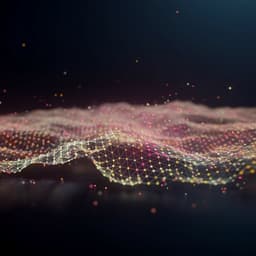
Engineering and Technology
Evaporate-casting of curvature gradient graphene superstructures for ultra-high strength structural materials
B. Lu, L. Yu, et al.
Discover groundbreaking advancements in material forming technologies with an innovative evaporate-casting strategy that produces graphene superstructures. This research, conducted by Bing Lu, Li Yu, Yajie Hu, Ying Wang, Fei Zhao, Yang Zhao, Feng Liu, Huhu Cheng, and Liangti Qu, addresses internal stress and defects in materials, aiming for enhanced mechanical properties and processing precision.
~3 min • Beginner • English
Introduction
The study addresses a central challenge in structural material processing: internal stress and defects generated during forming degrade intrinsic mechanical properties and precision. Building on advances in two-dimensional materials, the authors aim to harness internal stress rather than mitigate it, using a bottom-up self-assembly approach to create controllably shaped, robust materials. Prior assemblies of graphene sheets—porous, layered, and arrayed structures—require external forces for shaping but suffer from unpredictable interlayer slippage that introduces defects. The authors propose a graphene superstructure with a curvature gradient (cg-G): an arc-shaped assembly of graphene nanosheets around co-axial curvature centers. Inspired by the dehydration-driven curvature and stress coupling in bean pod tissues, they hypothesize that dehydration-based evaporate-casting can tighten assemblies via capillary action, induce local bending, and enable precise, programmable shaping by tuning geometric parameters (axis-center distance and tilt angle), while simultaneously enhancing strength via internally generated stress.
Literature Review
The paper situates its contribution within the literature on graphene-based microarchitectures and self-assembly. Previous work has demonstrated bottom-up assembly strategies using graphene and derivatives to form porous hydrogels/aerogels, layered films, and vertical arrays, with interactions such as π–π stacking and hydrogen bonding guiding structure formation. These architectures have enabled applications across energy storage, thermal interfaces, and structural materials but often require external forces or processes for shaping, during which random interlayer slippage can introduce defects and reduce precision. Gradient structures have been proposed to dissipate internal stress and regulate shape via chemical or physical gradients, though their precision and controllability remain limited. The present work advances this field by introducing a curvature gradient superstructure in graphene that leverages dehydration-induced capillarity to achieve predictable, programmable self-shaping while maintaining structural integrity.
Methodology
Materials synthesis and assembly: Graphene oxide (GO) dispersion was prepared via a modified Hummers method using graphite, sodium nitrate, sulfuric acid, potassium permanganate, and subsequent oxidation, quenching, and washing to neutrality. For cg-G, 60 mL of GO aqueous dispersion (3.5 mg mL⁻¹) was mixed with alkali (e.g., ammonium hydroxide, GO:NH₄OH 60:1 v/v, 32%; or KOH 0.15 mol L⁻¹), stirred 5 min, and hydrothermally treated in a 100 mL Teflon-lined autoclave at 180 °C for 6 h to form cylindrical graphene hydrogels with ordered concentric circle microstructures. The hydrogel was immersed in 1 M HCl for 6–8 h, rinsed thoroughly to remove residual acid, yielding cg-G. Mechanistically, alkali reacts with GO carboxyl groups, reducing hydrogen bonding and increasing electrostatic repulsion, promoting long-range lamellar ordering; surface anchoring by the reactor lining defines the macroscopic geometry. By changing autoclave lining shape, GO concentration (1.5–4 mg mL⁻¹), and alkali amount, varied geometries and microstructures were obtained.
Shaping by laser sculpturing and evaporate-casting: The concentric microstructured hydrogels were sculptured into designed profiles using a 355 nm UV laser cutting system (computer-controlled), defining the axis-center distance d (between geometric center O and curvature axis O′) and tilt angle θ (between the cylinder center axis and the normal to the slice plane). Evaporate-casting involved dehydration of the water-saturated hydrogel, during which capillary forces within wall grooves crumpled individual graphene nanosheets and tightened wall arrays, reducing inter-wall gaps and producing protrusions that interlock mechanically. Water acts as a plasticizer through hydrogen bonding to oxygen-containing functional groups, enabling nanosheet sliding during dehydration. The Kelvin effect accelerates evaporation on higher curvature regions, creating strain gradients that drive bending toward the curvature center. The macroscopic shaping is governed by the curvature gradient distribution, controlled via d and θ.
Characterization: Morphology and microstructure were examined by SEM and STEM to observe curvature gradients, wall alignment, protrusions, and serrated interlocking. XPS quantified oxygen content (~20%) indicating hydrophilicity; FTIR and EDS showed no compositional changes before/after dehydration; XRD showed no peak shift between hydrated/dehydrated states, indicating consistent interlayer spacing. Density was measured after deformation (~1.5 g cm⁻³). Mechanical testing (Shimadzu AGS-X) quantified compressive and tensile properties. Optical microscopy documented shape evolution. Comparative specific compressive strengths were plotted against metals and graphite.
Modeling and simulation: Finite element analysis (ABAQUS) implemented an equivalent temperature field to impose a radially varying shrinkage strain field ε(x,y,z)=−b(x²+y²)=−br² (ε<0 at the center; b>0 curvature deformation coefficient), with uniform z-direction loading to model ring-like distribution and decreasing strain rate with deformation to reflect evaporation kinetics. Geometry-specific microstructures were mapped by d and θ; predictions for in-plane and out-of-plane bending angles (α) and lateral dimensions were compared to experiments for cross and dumbbell shapes. Analytical relationships between radial strain ε_r and curvature radius ρ were posited (ε_r=ε₀+bρ², ε₀<0), linking curvature gradient to shrinkage. Coarse-grained MD simulations represented graphene sheets as particles with harmonic bond/angle/dihedral potentials and Lennard-Jones adhesion for graphene–graphene and graphene–water; periodic boundaries were used and the simulation box was reduced to mimic shrinking. Parameter variants explored twist-induced plasticity mediated by π–π adhesion of inter-adhering walls.
Demonstrations: In-plane and out-of-plane shaping of cross-shaped specimens with varying d were fabricated and dehydrated; dumbbell-shaped and arc-shaped slices were twisted by applying equal and opposite forces to impose initial twist angles (10°, 30°) to program out-of-plane helical deformations. A gasket-like centrosymmetric cg-G micro-fixator array was assembled and load-tested between stainless steel plates (1 mm thick). Mortise-and-tenon interlocking structures were fabricated by laser sculpturing mortise and by aligning the tenon’s curvature center with the mortise center to induce inward deformation and self-tightening upon dehydration; tensile performance and energy utilization were benchmarked against literature.
Key Findings
- Curvature gradient superstructure: cg-G comprises arc-shaped assemblies of graphene walls with co-axial curvature centers. SEM shows near-parallel walls far from the curvature center and pronounced curved arrays near the center, confirming a curvature gradient. Side-view sections show parallel wall/gap arrays.
- Dehydration-induced microstructural changes: Capillary forces during evaporation crumple graphene nanosheets forming protrusions; walls compact as inter-wall gaps shrink. STEM reveals serrated, mechanically interlocking protrusions. XPS shows ~20% oxygen content (hydrophilicity). FTIR/EDS indicate no change in functional groups; XRD shows no interlayer peak shifts between hydrated/dehydrated states.
- Mechanical performance: After deformation, cg-G exhibits density ~1.5 g cm⁻³ and specific compressive strength up to ~70 MPa cm³ g⁻¹, surpassing stainless steel (SUS304) and approximately doubling traditional graphene-based structural materials in the comparison set.
- Predictable, programmable shaping: By tuning axis-center distance d and tilt angle θ, both in-plane and out-of-plane bending are achieved upon evaporate-casting. Finite element analysis accurately predicts bending angles α and deformation modes across d=0, 3, 7 mm. Despite varying curvature gradients, the lateral length of structures remains nearly invariant, consistent with an ideal coaxial circular arc model.
- Anisotropic contraction: Dehydration leads to orthogonal contractions—along the wall plane and perpendicular to it—with an anisotropy factor measured at ~1.4 (contraction along wall plane relative to perpendicular). For a centrosymmetric cuboid, w/w′ > l/l′; l′/w′ is governed by microstructure and is stable across evaporation conditions.
- Strain–curvature relationship: A phenomenological relation ε_r=ε₀+bρ² (ε₀<0, b>0) captures greater shrinkage near higher curvature regions (Kelvin effect), explaining gradient-induced bending. Analytical predictions and FEA agree with experiments for cross and dumbbell shapes; dumbbells (θ≈45°) twist into stereo, centrosymmetric forms with trapezoidal bilaterally transformed cuboids.
- Plastic programmability via twisting: Applying equal and opposite forces to arc-shaped cg-G introduces twist angles (10°, 30°), shifting the curvature-center direction out of plane. CG-MD indicates system energy first increases then decreases as twist increases due to π–π-driven wall adhesion; once energy drops below zero, the structure exhibits plasticity and retains shape. Evaporate-casting then yields helical architectures with varying pitches; post-deformation twist angles exceed initial ones due to combined configurational forces.
- Macroscale self-tightening and strength: A centrosymmetric gasket-like cg-G array (five micro-fixators) sandwiched between 1 mm stainless steel plates endured a car (~1200 kg) passing over, imprinting pits in steel while the cg-G remained intact. Mortise-and-tenon assemblies self-tighten during dehydration; SEM shows tight joints and slight shoulder deformation consistent with centripetal tenon shrinkage. A ~1 mm³ interlock lifted ~300,000× its own mass (e.g., a ~1.28 kg laptop with ~4.2 mg connector). The mortise–tenon joint shows specific connection (tensile) strength up to ~143 MPa cm³ g⁻¹, comparable to welded metals; the abstract reports joining strength up to ~200 MPa. Energy utilization during preparation is 1–4 orders of magnitude higher than various comparators (3D-printed structures, self-healing polymers, welded joints) in the Ashby diagram.
Discussion
The results demonstrate that internal stresses inherent to material forming can be co-opted as a constructive shaping force when embedded within a well-organized curvature gradient architecture. Dehydration-driven capillary forces and curvature-dependent evaporation (Kelvin effect) generate anisotropic, spatially graded shrinkage that translates microscopic wall crumpling and tightening into macroscopic bending with high fidelity. Control via axis-center distance d and tilt angle θ enables precise programming of in-plane and out-of-plane deformations, with FEA and analytical models accurately predicting outcomes, underscoring the robustness of the mechanism. The hierarchical interlocking of crumpled protrusions preserves and enhances mechanical integrity, yielding specific compressive strengths outperforming metals and conventional graphene assemblies. The self-tightening mortise-and-tenon joints leverage centripetal deformation to achieve strong, binder-free connections with specific strengths rivaling welded metals, and energy utilization metrics superior to other joining/printing methods. Collectively, these findings address the longstanding issues of precision loss and defect formation in material processing by converting internal stress into a controllable driver of both shape formation and mechanical reinforcement, with scalability, environmental friendliness, and versatility suitable for applications from micro-fixators to robust structural connectors.
Conclusion
This work introduces evaporate-casting of curvature gradient graphene (cg-G) superstructures as a general strategy to harness dehydration-induced internal stresses for precise, programmable shaping and reinforcement of structural materials. By engineering arc-shaped, co-axial assemblies and controlling geometric parameters (d, θ), the process delivers predictable in-plane and out-of-plane deformations validated by simulations. Hierarchical wall crumpling and interlocking yield high specific compressive strength (~70 MPa cm³ g⁻¹) and enable macroscale self-tightening mechanisms, including mortise-and-tenon joints with specific tensile strengths up to ~143 MPa cm³ g⁻¹ and reported joining strengths up to ~200 MPa. The approach is controllable, scalable, cost-effective, and environmentally friendly, opening avenues for robust, precisely shaped components and high-strength, binder-free connections. Future work could explore extending curvature-gradient evaporate-casting to other 2D or layered materials, optimizing microstructural parameters for tailored anisotropy, integrating multi-physics models for process control, and developing application-specific devices and joints across length scales.
Limitations
Related Publications
Explore these studies to deepen your understanding of the subject.







